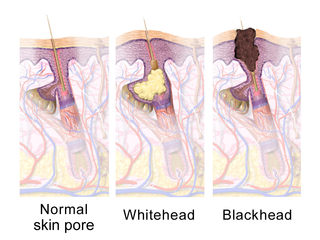Dermatology is the branch of medicine dealing with the skin. It is a speciality with both medical and surgical aspects. A dermatologist is a specialist medical doctor who manages diseases related to skin, hair, nails, and some cosmetic problems.

Pimecrolimus is an immunosuppressant drug of the calcineurin inhibitor class used in the treatment of atopic dermatitis (eczema).

Ichthammol or ammonium bituminosulfonate, also known as black ointment, is a medication derived from sulfur-rich oil shale. It is used as a treatment for different skin diseases, including eczema and psoriasis. It is applied on the skin as an ointments, most commonly containing 10% or 20% ichthammol.

A comedo is a clogged hair follicle (pore) in the skin. Keratin combines with oil to block the follicle. A comedo can be open (blackhead) or closed by skin (whitehead) and occur with or without acne. The word "comedo" comes from the Latin comedere, meaning "to eat up", and was historically used to describe parasitic worms; in modern medical terminology, it is used to suggest the worm-like appearance of the expressed material.

Horatio George Adamson was a British dermatologist. He studied at St. Bartholomew's Hospital receiving his medical doctorate in 1888. He learned dermatology at the Middlesex Hospital in London from John James Pringle. Between 1909 and 1928, he lectured and practiced dermatology at St. Bartholomew's Hospital.

Henry Radcliffe Crocker, FRCP was an English dermatologist. Originally from Hove in Sussex, England, Crocker started his working life as an apprentice to a general practitioner before going to London to attend the University College Hospital medical school. Working as a resident medical officer with William Tilbury Fox, Crocker began a lifelong career in dermatology. With his 1888 book Diseases of the Skin: their Description, Pathology, Diagnosis and Treatment, he became known as a leading figure of dermatology.

The British Journal of Dermatology is a monthly peer-reviewed medical journal that covers the field of dermatology. It is published by Wiley-Blackwell on behalf of the British Association of Dermatologists. The journal was established in 1888 and the editor-in-chief is John Ingram. According to the Journal Citation Reports, the journal has a 2020 impact factor of 9.3., ranked third within the dermatology subject category.
George Hector Percival FRSE FRCPE (1902–1983) was a British dermatologist, academic author and president of the British Association of Dermatologists.

Cicely Pearl Blair FRCP was a British dermatologist. She discovered that people who had albinism did not get blackheads, as they did not produce melanin, the pigment that makes the comedones black. She also wrote about rashes caused by brown-tailed moth caterpillars. After her retirement, she turned her hand to art and especially silver smithing, fashioning a "chain of office" for the president of the British Association of Dermatologists.

Peter Edward Darrell Sheldon Wilkinson was a leading figure in dermatology who was consultant at Aylesbury and High Wycombe, co-edited the first edition of Rook's 1968 Textbook of Dermatology and founded the International Foundation for Dermatology in 1987.

Sir Norman Purvis Walker FRCPE was a Scottish dermatologist, and physician-in-charge of the Skin Department at the Royal Infirmary of Edinburgh. He was also one of the first persons in Britain to benefit from the discovery of insulin as a treatment for diabetes.
Peter William Monckton Copeman FRCS was an English dermatologist known as "Dr Spot" by his colleagues. He was consultant physician at Westminster Hospital and consulting dermatologist at Chelsea and Westminster Hospital. He treated many celebrities and also helped modernise Qatar’s medical services. He authored over a hundred peer-reviewed articles and pioneered research on allergic vasculitis and malignant melanoma.

Rook's Textbook of Dermatology is a leading textbook of dermatology published by Wiley. The ninth edition was published in 2016.

Arthur James Rook FRCP was a leading British dermatologist and the principal author of Rook's Textbook of Dermatology (1968), known as "Rook's", which reached its ninth edition in 2016.

Ian Wesley Whimster MRCPath was a reader of dermatology histopathology at St Thomas' Hospital, London. He gained international recognition for his study of comparative anatomy and experiments with reptiles, particularly observing their colour patterns in relation to their nerve supply. He was part of the medical student team that went into Bergen-Belsen concentration camp in 1945, after it was liberated by British troops. On return, he made numerous contributions to dermatology, including the definition of keratoacanthoma, the distinction between pemphigus and pemphigoid and descriptions of melanocytes and malignant melanoma. He died in a road traffic accident at the age of 55.

Walter Freudenthal was a German-Jewish dermatologist who gave the earliest clear histopathological description of keratoma senile in 1926 in Breslau. In 1933, he moved to London to escape the Nazi regime and worked as a dermatopathologist at University College Hospital (UCH) in London where he coined the term keratoacanthoma in the 1940s.
Sir Archibald Montague Henry Gray was a British dermatologist and gynaecologist, who was consulting physician for diseases of the skin at University College Hospital and to Great Ormond Street Hospital. Between 1948 and 1962, he was adviser in dermatology to the Ministry of Health. Between 1940 and 1942, he was president of the Royal Society of Medicine. In England, he was first to perform a Wertheim hysterectomy.

Max Jessner was a German dermatologist and university professor. In 1928 he travelled to Buriat-Mongolia on an expedition to study syphilis and the effects of the anti-syphilitic drug Salvarsan. After escaping Nazi occupied Europe in the mid-1930s, he settled in New York. Jessner is remembered for the development of the chemical peel known as Jessner's solution and the description of Jessner-Kanof disease.
Christopher Barry Bunker, is a British dermatologist.
Daniel Turner was a London physician who published the first textbook on dermatology in English. De Morbis Cutaneis was first published in 1714 and went through several English editions. It was also published in French and German.













